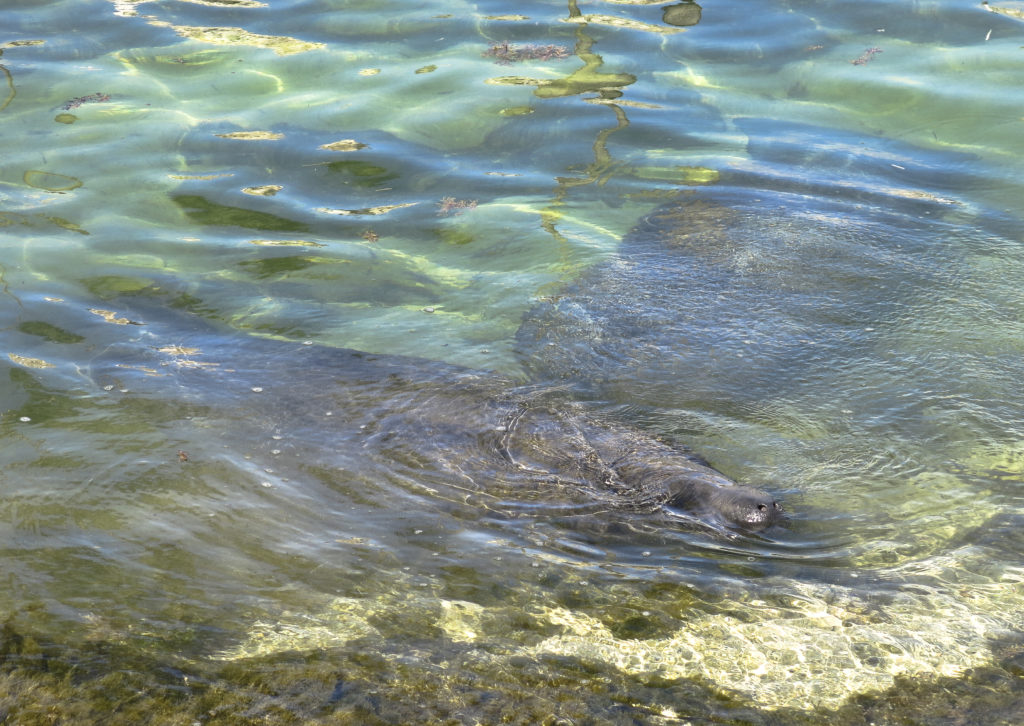Creature Feature

The Plight of the Manatee
By Wayne Bierbaum
Growing up in Florida, I visited Crystal River on several occasions and always in the winter. After college, I even went diving there. The reason I visited in the winter was that was the time of year when the water was actually warmer than the air.
Fish and other animals swam into the river from the colder Gulf of Mexico. Tarpon, speckled trout, redfish and mullet became concentrated in the warm freshwater. Along with the fish came massive manatee sea cows looking for warmth and food.
In the main spring there sometimes were as many as 20 manatees, calmly lounging in the broiling springs. As the water spilled out from the springs and became a river, thick underwater grasses and plants turned the river green from shore to shore. Manatees could be seen foraging on the plentiful plants. Visitors to the springs were not allowed to approach the manatees but occasionally, they would approach you. They were friendly and curious.
There are three species of manatees in the world. They all have a paddle-shaped tail and a face like a walrus. Dugongs are their closest relatives and you can tell the difference between them by their tails, a dugong’s tail is fluked like a dolphin’s. On land, the manatee’s closest relative is the elephant.
Florida’s West Indian manatees are quite large, growing to be as big as 15 feet long and weighing in at 3,900 pounds. In 1960, the average life span of a manatee was estimated to be about 60 years. Females will give birth to one calf at a time and it takes two years to wean. They become sexually mature in about five years.
When I lived in Miami, I would frequently see manatees along the edge of Biscayne Bay. One of my medical school lab partners was a marine biologist that specialized in the study of these herbivores. When a manatee was found dead, he and I would investigate to determine the cause of its demise.
Boat strikes, pneumonia and crush injuries by flood gates were the most common causes. Unfortunately, over the past several years, the cause of death has dramatically shifted. They are now dying more frequently from starvation or red tide poisoning. The overwhelming root cause is human-created severe environmental changes.
The seagrasses the manatees feed on need sunlight. Those grasses are disappearing because of mats of algae blocking out the sun. Without food, the manatees starve.
Warm weather blooms of dinoflagellates, another type of algae, cause the poisonous red tides and manatees trapped in it have died. Algae blooms are easily linked to excessive nutrients accumulating in estuarial waters. The nutrients come from fertilizer, sewage and runoff. The problem is made worse with stagnation caused by fill islands blocking tidal and river flow.
Studies published by the University of South Florida state the largest manatee die-off yet recorded happened in 2021 when a staggering 1,101 bodies were found. That is three times the previous average death rate prior to 2015. The total population in Florida was estimated to be around 8,800 at the beginning of 2021. Over 20 percent of the population along the East Coast perished. The epicenter of the die-off is the Indian River region where in four years 60 percent of the underwater seagrass disappeared due to algae blooms.
Trying to save the starving animals with food handouts hasn’t worked as they are shy but also because each requires 100 to 200 pounds of grasses a day and they won’t eat the stagnant water algae. Stopping the algae blooms is the key to the health of the manatee.
This problem sounds a lot like what has happened to the Chesapeake Bay. Return the underwater grasses and plants and then there will be a nursery area for crabs and fish. Difficult-to-reverse human forces are preventing true improvements both here and in Florida where the manatee population is collapsing to the brink.
